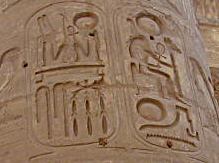 | These are from the hypostyle hall at Karnak |
The Temple of Amun was constructed by Amunhotep III (1386-1349 BCE), the 18th Dynasty pharaoh who was the father of the so-called heretic pharaoh, Akhenaton. On the west Nile bank, Amunhotep's magnificent mortuary temple is now an open field save for the two monolithic statues known as the Colossi of Memnon. The Luxor Temple, however, was protected through the ages by a deep layer of sand that was only removed in the 1880s. But not before it had been added to by Tutankhamen, Ay, Horemheb, and -- of course! -- Ramesses II (1278-1212 BCE).
The entrance to the temple today is through the great pylon erected by Ramesses II. The seated colossi are of Ramesses, naturally. Originally an obelisk flanked each statue. The tourist must travel to Paris to see the one missing here; it's in the Place de la Concorde. Footnote: When the French took down the obelisk for shipping, what should they find on its foot where it would never be seen except by a later king intent on stealing the monument or claiming it as his own? Ramses' cartouche.
|
Visible through the pylon in the outer court of the temple is the minaret of the mosque of Yusuf al-Haggag, local Muslim saint who lived for many years in Luxor, dying there in 1245 CE. Built in the early 19th century, the mosque was at ground level -- until those pesky archeologists came along and carted away the centuries-long accumulation of sand to reveal the magnificent New Kingdom temple beneath. The mosque was left hanging in the air, so to speak, but existing within the temple of Amun. Moreover, a living, breathing memory of Amun and the Opet festival is celebrated each year at the feast of al-Haggag, when a procession of boats enlivens the temple and mosque. There is little of Islam in the feast and the details of Amun 's celebration are long lost -- but somehow the memory lives on.
| Ramesses was inordinately proud of his "victory" over the Hittites at Kadesh (in modern Syria) in his fifth regnal year (1275 BCE). During most of the 2nd millennium BCE Egypt and Hatti were opposing superpowers. Hatti, in what is modern Turkey, and Egypt, in the Nile valley, fought for control of the mini-states between them and thus for control of vital trade routes. Ramesses had prepared for this decisive battle from the moment he became king and, probably even before when he was co-regent with his father, Seti I. It became the defining battle of his reign, or so he thought, and he plastered his version on several of his temple walls, including this one at Luxor on the pylon to the left of the remaining obelisk. The most thoroughly documented military encounter in ancient history (there is also a Hittite version), the battle of Kadesh was actually a draw; neither side won decisivly. The Hittities kept control of Kadesh and Ramesses went home to declare his personal valor. In an age without television and the internet, how were the Egyptians to know otherwise? |
| Ramesses II reigned for 67 years and had many sons, a goodly number of whom died before he did, which means he continually had to revise his nomination of the "crown prince." Here, on the wall of the Luxor Temple, is a depiction of a procession of his sons. The names attached to these figures help in the identification of artefacts in KV5, where many of those sons are buried.
|
away on the back of walls and pillars. This one is in the Ramesses II deep relief style. |  Ramesses' court, was begun by Amunhotep III and completed by Tutankhamun. |